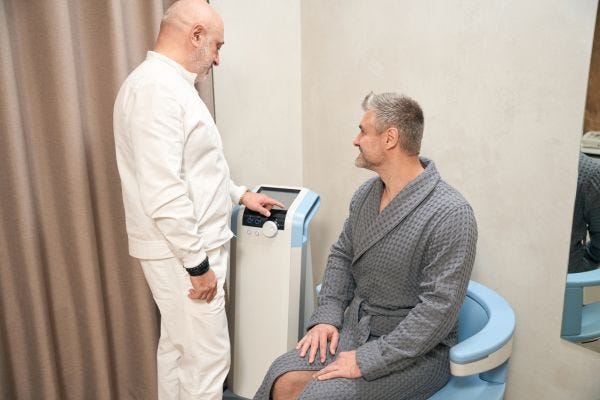Edited by Marlee Septak, Copywriter at Aeroflow Urology.
Your pelvic floor is an integral part of bladder control. It helps maintain sexual function, core stability, and other important bodily activities. That’s why you must care for your pelvic floor just as you would the rest of your body! But how do you know when your pelvic floor requires attention? And what happens at a pelvic floor physical therapy appointment?
This article will answer these questions, plus many more, and give you expert advice from Susie Gronski, Licensed Doctor of Physical Therapy and Certified Pelvic Rehabilitation Practitioner. We’ll also tell you how to get free protective products if you’re experiencing bladder leaks from pelvic floor issues.
What Is Your Pelvic Floor?
The pelvic floor is a multifaceted system within the pelvic region that includes the:
- Pelvic bones.
- Genitals
- Bladder
- Prostate or uterus.
- Rectum
- Pelvic muscles.
- Nerves
- Connective tissue.
- Blood vessels.
Check Your Eligibility
2 Easy Steps
From catheters to pediatric and adult incontinence supplies, discover the continence care essentials covered by your insurance.

There are 2 groups of muscles in your pelvic floor: The superficial and deep.
Comprised of a triangular arrangement of muscles that encircle the penis, or vaginal opening and clitoris, playing a crucial role in sexual function and orgasm sensation. This group includes the anal sphincter, responsible for controlling the release of gas and supporting bowel continence (bowel control), and the external urethral sphincter, which helps maintain urinary continence (bladder control).
This group is called the levator ani (‘levator’ meaning to elevate / lift— ani meaning anus— muscles. This group of muscles extends from the pubic bone to the tailbone, supporting the bladder, prostate or uterus, and rectum. These muscles function like a sturdy trampoline, ensuring stability for the pelvic and abdominal organs, especially when subjected to varying loads and pressure changes.
Functions of Your Pelvic Floor Muscles
Sphincteric control: Help control bladder and bowel function, ensuring continence during closure and relaxation during urination and defecation.
Stability: Contribute to overall body stability, working alongside other muscle groups for posture and adaptability.
Support: Supports abdominal and pelvic organs, preventing conditions like pelvic organ prolapse.
Pressure regulation: Coordinate with the diaphragm muscle to manage intracavitary pressure during activities like lifting or coughing.
Sexual function: Important for sexual function (for example, erection and ejaculation) and orgasm, enhancing pleasurable sensations.
What Exactly Is Pelvic Floor Therapy?
Pelvic floor physical therapy (PFPT) or occupational therapy, also known as pelvic floor rehabilitation, is a highly specialized and trained form of medical therapy that focuses on improving the function of the pelvic floor muscles for any person with a pelvis. Basically, any change “down there” that is affecting your ability to engage in what is meaningful to you is what pelvic therapy can support.
Why Would You Need Pelvic Floor Therapy?
PFPT may be a good idea if you are experiencing any of the following:
- Pelvic pain.
- Sexual pain (vulvar, vaginal, anal, penile, or otherwise).
- Painful intercourse.
- Pain with bowel movements.
- Anal pain.
- Genital pain.
- Urinary or fecal incontinence.
- Constipation


- Urinary urgency or frequency.
- Pelvic organ prolapse (bladder, urethra, uterus, rectum).
- Sexual recovery post prostate cancer treatment.
- Penile rehabilitation post prostate-cancer surgery (or any surgery that affects genito-pelvic tissue/organs).
- Sexual dysfunction.
- Abdominal pain.
- Lower back pain.
- Hip pain.
- Post gender-affirming surgery.
- Any change “down there” that affects your ability to engage in what is meaningful to you.
What Are the Benefits of Pelvic Floor Therapy?
PFPT can help you regain your quality of life. It can help you return to enjoyable activities with greater self-reliance, functionality, and confidence. It can help you regain bladder and bowel control, lessen symptoms of urinary incontinence, help with sexual issues, pain in the body, and even relieve constipation.
What Should You Expect at Your Pelvic Floor Therapy Appointment?
While every PFPT appointment will differ based on your needs and your therapist’s techniques, your first PFPT appointment may include the following.
- Medical history intake and review.
- Comprehensive sexual health intake.
- Biofeedback.
- An explanation of findings.
- Collaborative plan of care and goal setting.


- Orthopedic assessment of back, hips, and pelvis, which includes posture and functional movement observation, strength and mobility testing, and sensory testing.
- External genital exam and, if necessary, internal examination of the pelvic floor muscles to evaluate tone, tenderness, strength, and function. The internal examination is performed with your informed consent and is considered a standard part of pelvic floor assessment (a witness is always welcome in the room per your request). Although considered “standard,” no part of the pelvic assessment is absolutely required. It is imperative that your healthcare provider is sensitive to your unique experiences and needs, offering trauma-informed support to maintain the integrity of your emotional and physical well-being!
After an initial pelvic floor assessment, your pelvic health therapist will jointly discuss the approximate number of sessions you need, depending on the complexity of your health concerns and goals. Establishing the number of visits is a collaborative process that considers your specific needs, goals, and resources.
Your insurance plan may cover PFPT. However, not all pelvic therapy providers participate in insurance-based care models, but this does not mean pelvic therapy is not covered! Check with your insurance plan and PFPT office to ensure you’re covered for your care.
What Should You Expect From Pelvic Floor Treatment?
Again, every PFPT visit and each treatment option will differ based on your therapist and which type of pelvic floor dysfunction or other issue you’re facing. At Gronski’s practice, patients receive a custom-tailored treatment plan aligned with their specific needs and goals. This plan might encompass a blend of:
- Exercises
- Stretches
- Hands-on techniques.
- Lifestyle change recommendations.
Gronski says she encourages her patients to embrace a holistic perspective and acknowledge that well-being goes beyond physical health. It encompasses psychological, social, cultural, and relational aspects that all intersect. This means that her patients’ care plan may encompass additional supportive services, including sexuality counseling, mental health therapy, and nutrition therapy, depending upon the intricacy of their pelvic and sexual health concerns.
Other lifestyle changes you can make during your PFPT treatment include:
- Dietary modifications to reduce potential bladder irritants, such as caffeine and alcohol.
- Staying generally physically active and performing kegel exercises to strengthen the pelvic floor.
- Using medical devices like a pessary or a neurostimulator.
- Using continence care products, like absorbent pull-ons or bladder pads.
- Using medications to help with urinary incontinence.


- Discussing surgeries with your primary care provider or urologist to help regain continence.
How Can You Get Free Protective Products for Incontinence?
Managing bladder leaks— even while receiving PFPT to end symptoms— can feel embarrassing and worrisome. Lessen your worry by using adult incontinence products, such as bladder control pads, protective underwear, or briefs. These absorbent and reliable supplies help control leakage while keeping your skin dry and comfortable.
The best part is that you can receive the products you want to use for free! Your Medicaid or Medicaid-managed care plan may cover the total cost of your supplies. To find out if you qualify, follow these 3 simple steps.
- Fill out the secure and simple Aeroflow Urology Eligibility Form. It takes less than 5 minutes. Just have your insurance card at hand!
- Wait for a confirmation of benefits text or email from Aeroflow Urology’s expert insurance team. This usually takes 1-2 business days.
- Reach out to your healthcare provider for a prescription for incontinence (this is required by insurance plans to verify your medical reason for needing products).
After you’re approved, you’ll be able to choose your incontinence supplies that are 100% covered by your insurance plan. Your products will quickly arrive at your front door in discreet packaging. You can expect to receive reminders when it’s time to refill your products every month.
Disclaimer
Information provided on the Aeroflow Urology blog is not intended as a substitute to medical advice or care. Aeroflow recommends consulting your healthcare provider if you are experiencing medical issues relating to incontinence.











